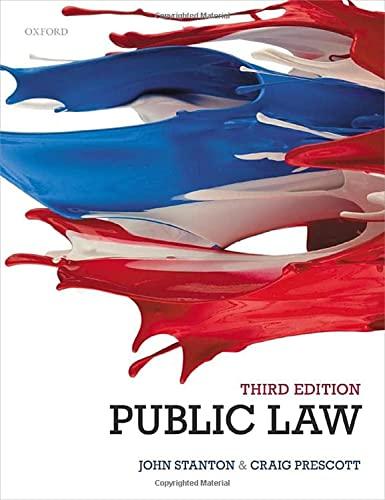Question
Question 1 5 point Article 1, Section 11 of the Florida Constitution states No person shall be imprisoned for debt, except in cases of fraud.
Question 1
5 point
Article 1, Section 11 of the Florida Constitution states "No person shall be imprisoned for debt, except in cases of fraud".
Group of answer choices
True
False
Question 2
5 points
In Florida, citizens have a Right to Privacy under Article 1, Section 23, of the Florida Constitution.
Group of answer choices
True
False
Question 3
Law is defined in your text as "a body of rules of action or conduct prescribed by controlling authority, and having binding legal force. That which must be obeyed and followed by citizens subject to sanctions or legal consequence is a law."Black's Law Dictionary, 6th ed.,
Group of answer choices
True
False
Question 4
When America was formed, there was no formal legal system in place. What did early, 18th Century, Americans use as the basis for today's legal system?
Group of answer choices
The US did not have a legal system until 1789
The Used the French Legal System as a Foundation
Started a New System From Scratch
Relied on English Common Law
Question 5
In a lawsuit between two private, business professionals-- the accused party has the right to remain silent. That is, the defendant cannot be forced to testify against himself because of his/her 5th Amendment privilege against self-incrimination.
Group of answer choices
True
False
Question 6
A plaintiff in a lawsuit seeks a "remedy". Which of the following would be considered a remedy?
Group of answer choices
Money Damages
Specific Performance
Injunction
All of the Above
Question 7
A law must be ethical before it is enforceable.
Group of answer choices
True
False
Question 8
Intellectual property is an asset, owned by a company, yet capable of being in intangible form (unlikereal property). Ideas, words, images, designs, publicity rights, and trade secrets can be owned under the law.
Group of answer choices
True
False
Question 9
A "grant from government that gives an inventor the exclusive right to make, use, and sell an invention for a period of twenty years. . . " best defines:
Group of answer choices
A copyright
A trademark
A patent
A trade secret
Question 10
Congress' authority to grant patents and trademarks is found in Article I, Section 8, of the US Constitution. This the same section of the Constitution that grants Congress its authority to regulate interstate commerce.
Group of answer choices
True
False
Question 11
An invention to be granted a patent by the US Patent and Trademark Office if the invention is novel, useful, and non-obvious in light of current technology.
Group of answer choices
True
False
Question 12
Four main sources of law in the U.S. legal system are:
Group of answer choices
Constitutional law, criminal law, civil law, and maritime law
Federal law, state law, international law, and maritime law
statutory law, case law, equity, and common law
Constitutional law, judicial law, statutory law, and executive orders
Question 13
Subject Matter jurisdiction is the power of the court to hear and decide, the kind of case filed.
Group of answer choices
True
False
Question 14
The elements of trade secret include:
Group of answer choices
concept & secrecy
originality & goodwill
originality & secrecy
concept & engineering
Question 15
The Economic Espionage Act (EEA) of 1996 makes the theft or misappropriation of a trade secret a state crime.
Group of answer choices
True
False
Question 16
Copyright is the legal protection of ideas,
Group of answer choices
True
False
Question 17
In analyzing the Fair Use Doctrine, factors to be in considered include:
Group of answer choices
the purpose and character of the use, including whether such use is of a commercial nature or is for nonprofit educational purposes
the nature of the copyrighted work
the amount and substantiality of the portion used in relation to the copyrighted work as a whole
the effect of the use upon the potential market for or value of the copyrighted work
all of the above
Question 18
Trademarks and other kinds of marks may consist of words and phrases, pictures, symbols, shapes, numerals, letters, slogans, and sounds.
Group of answer choices
True
False
Question 19
According to the court in Lopez v. Nike, to state a claim under the Lanham Act for trademark infringement, unfair competition, and false designation of origin, a plaintiff must establish:
Group of answer choices
(1) strength of the trademark; (2) similarity of the marks; (3) proximity of the products and their competitiveness with one another; (4) evidence that the senior user may "bridge the gap" by developing a product for sale in the market of the alleged infringer's product; (5) evidence of actual consumer confusion; (6) evidence that the imitative mark was adopted in bad faith; (7) respective quality of the products; and (8) sophistication of consumers in the relevant market.
(1) he owns a valid mark entitled to protection under the Lanham Act; (2) defendant used the protected mark in commerce, without plaintiff's consent; and (3) "defendant's use of that mark is likely to cause consumers confusion as to the origin or sponsorship of the defendant's goods."
(1) advertising expenditures; (2) consumer studies linking the mark to a source; (3) unsolicited media coverage of the product; (4) sales success; (5) attempts to plagiarize the mark; and (6) the length and exclusivity of the mark's use.
Question 20
Florida's court system consists of the following entities: the supreme court district courts, circuit courts and county courts.
Group of answer choices
True
False
Step by Step Solution
There are 3 Steps involved in it
Step: 1

Get Instant Access to Expert-Tailored Solutions
See step-by-step solutions with expert insights and AI powered tools for academic success
Step: 2

Step: 3

Ace Your Homework with AI
Get the answers you need in no time with our AI-driven, step-by-step assistance
Get Started


